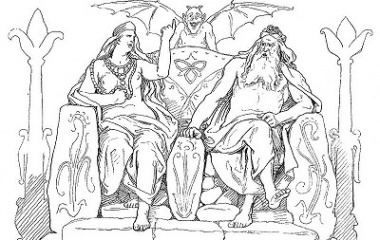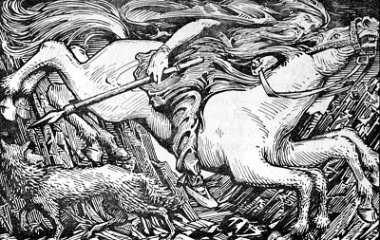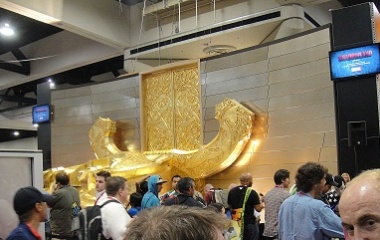- Pronunciation: OH-din
- Origin: Germanic, Norse
- Role: God of Healing, Death and Knowledge
- Parents: Bor and Bestla
- Children: Balder, Hod, Hermod
- Symbol: Triple Horn
- Other Names: Woden, Wotan
Who Is Odin?
In Germanic and Norse mythology, Odin was the chief god. He was the son of Bor and Bestla and rose in fame mostly because of the Vikings admiration. During the eighth and ninth centuries, he was known as the supreme god. The Vikings admired the god’s love for battle and he became known as the “father of the slain” while also demonstrating the importance of warfare.
While he rose to fame in Germanic mythology, he was associated with knowledge, sorcery, healing, death, battle, poetry, and the runic alphabet in Norse mythology. He was the ruler of the Aesir, a group of gods. He played a central role in many myths surrounding the creation and destruction of the world.
Purpose
Odin was known for his love of causing conflicts and shifts in power. For example, he aided a Danish King named Harold in war tactics and helped him achieve victory for years. But in the final battle, Odin took the place of Harald’s enemy and conquered him.
While Odin was known for his dabbling in deceit, violence, and war, he also possessed many admirable qualities. He was the wisest god and proved several times that he would sacrifice anything, including himself, for more knowledge.
Odin was the recipient of many human sacrifices, especially those who were royalty, nobles, or from enemy armies. The sacrifices were typically completed by a spear, noose, or both.
Origins
The exact origins of Odin are unknown but many believe that he is an evolved concept based on a mostly overlooked proto-Norse god. The name of this god, who would have been worshiped during the Migration Period, is unknown but speculated to be close in spelling to Odin, such as Wodin. Tyr was the original king of the gods. But Odin, who had roles similar to those of Zeus and the Celtic god Lugh, would quickly assume the position. Because of this transition of power, many wonder if the battle between the two tribes of gods, the Vanir and the Aesir, is more symbolic than it first appears to be.
Legends and Stories
There are many myths, both of Norse and Germanic origin, that tell about Odin’s life. They were originally handed down orally by poets. When the Norse came across the Christians, they eventually adopted the Roman alphabet. It was then that they began to write down the stories. The traditions of passing the stories down orally died out as people began to rely on written versions of the tales. Some go as follows.
The Myth of Odin’s Missing Eye
Odin was willing to pay any price for wisdom and was always looking for new quests. He wanted to understand life’s mysteries and answer every question. On one occasion, he headed towards Mimir’s Well, otherwise known as the Well of Urd. It was among the roots of the world-tree and was home to Mimir, a dark and shadowy creature whose knowledge could not be matched by anyone else. Mimir had acquired his knowledge by drinking water from the well.
Odin wanted to take a drink from the well and asked Mimir for permission. Mimir agreed, but only if Odin would give him one of his eyes. It is unknown how much time passed after this demand, or whether or not Odin debated or argued with Mimir, but he did eventually gouge out one of his eyes and drop it straight into the well in front of Mimir. With the task complete, Mimir took his horn and dipped it into the well, retrieving a large drink of the enchanted water. Odin drank from the horn and received the wisdom it contained.
Odin’s Self-Sacrifice
Here’s yet another myth about Odin’s search for infinite wisdom. He sacrificed “himself to himself” by hanging on Yggdrasil, the world-tree. He then stabbed his side with a spear and remained there for nine nights and nine days. He received no food or water during this display. At the end of it all, he received the runes, the name given to the magically-charged ancient alphabet of the Germans. It was said to hold many of the secrets of existence. In the written myths, the following quote is spoken by Odin after receiving the runes.
“Then I was fertilized and grew wise;
From a word to a word I was led to a word
From a work to a work I was led to a work.”
Odin Tricks a Giant
One day, Odin’s competitive side drove him to challenge the wisest of all the giants in the land. He challenged the giant to a contest regarding knowledge. The prize was fierce. The winner would receive the head of the loser. Because of all his knowledge, Odin won the contest by asking his opponent something that only Odin would know. His competitive nature was stronger than his morals. He claimed his prize and returned home.
Family
Odin was the son of Bor and Bestla. He had many other names, including Alfather and Alfadir, both signifying his reputation as the father of the gods. He was married to Frigg, who was the mother of Balder, Hod, and Hermod. Odin fathered Thor with a goddess named Jord and Vider with a giantess named Grid.
Appearance
Odin has been described as having only one eye and a long beard. In artistic representations, he is carrying a spear named Gungnir and wearing a cloak and hat. He is usually being followed by his animal companions, wolves named Geri and Freki and ravens named Huginn and Muninn. He also owned a horse named Sleipnir who could fly and had eight legs. He rode Sleipnir across the sky and into the underworld.
Symbology
The most recognized symbol of the god is the Triple Horn of Odin. It consists of three drinking horns, all interlocked, and is a common symbol of the Asatru faith. The symbol is a tribute to the horns mentioned in mythological stories of Odin and for their use in traditional Norse toasting rituals. Several of Odin’s myths involves his quest for a magical mead brewed from a god’s blood, which he would drink from his horn.










